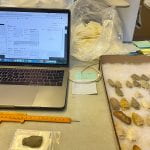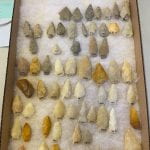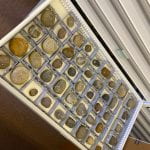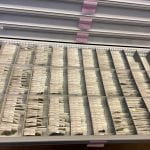Engaging the Americas Grant Collections Reflections
Jessica Nelson, Mellon Curatorial Assistant
Since rejoining the Haffenreffer Museum in Fall 2019, I’ve been tasked with the gargantuan task of inventorying, cataloging, rehousing, and (when needed) relabeling the archaeological assemblages from the Americas in our collections in preparation for the anticipated move from Bristol to Providence. These archaeological materials, predominantly comprised of stone tools from the Northeast and the Mississippi watershed, form a bedrock of the Museum’s collections and represent a major collecting interest of Rudolf Haffenreffer upon the founding of his King Philip Museum. Stored in the attic of “the Barn” for decades, this voluminous assemblage is now shifting to new housing in specially purchased cabinetry that can transition easily to the new space. Objects are rehoused according to their size, material, and number for ease of retrieval.
Most days, you’ll find me working at my station in the Barn, cataloging and rehousing another box of objects from the attic. I describe and measure each object, recording the data in our database, MuseumPlus, and correcting any errors in the file. I update the record to reflect the artifact’s new storage location, and rehouse the object in an appropriately sized bag or box. This packaging is labeled, and, if the original object number is unclear or if the number was duplicated, the object itself is relabeled. Object labels are printed on acid free paper and adhered to the artifacts in a two-step process that sandwiches the label between layers of water-soluble, non-reactive glue. Boxes have to be built and lined for the larger objects and bags need to be lined with foam for the smaller, less bulbous materials. After objects have been processed, they can be put away in their new storage locations and slated for photography.
This is a time-consuming process to purse on a large collection; fortunately, I’ve been able to recruit others to aid me in this endeavor! Student employees Makoto Kobayashi, Grace Ermias, and Alisa Caira have all pitched in on this effort, spending hours labeling objects with duplicated numbers, building and lining boxes, transferring materials from the attic, cleaning objects, and putting rehoused objects away in the drawers. With their help, the periodic assistance of the of Collections Assistants who were working on the Transforming the Haffenreffer grant as they encountered archaeological materials, and building on the work of my predecessor, we’ve rehoused nearly 13,000 objects into the new cabinetry to date! There’s a lot more to go, but we are making progress on moving this assemblage out of the attic and into the cabinets, all so it will be ready for the big move from Bristol when it comes.
Photos by Jessica Nelson
Matthew Longchamps, Mellon Photographer
I have always been fascinated by history and the objects that are left behind. I started working in museum photography to learn more about the world we live in and the cultural artifacts that tell these stories. Working at the Haffenreffer on the Engaging the Americas grant is an incredible opportunity to document many objects that can teach us more about Native American culture and make these objects more readily available for research and teaching.
This documentation project is a wonderful chance for the museum to inventory, catalog and photograph large amounts of objects in the collection. This will be used to enhance the object database records which will ensure this information can reach a larger audience. Since starting, I have already photographed thousands of objects and these photographs, uploaded onto the database, are available for researchers to view them online, making them available around the world.
I am always interested to learn more about the objects I photograph and on this project I am working on a large number of projectile points and scrapers. It is fascinating to see the different materials the objects are made from, the different techniques that were used to create them and the different shapes that they are made in. Each object tells a story of what it was used for and what we can learn about the people that made and used them. As a photographer I am a visual learner so I am especially pleased I can help other people learn about these objects through the photographs I am taking.
Cover photography by Juan Arce





